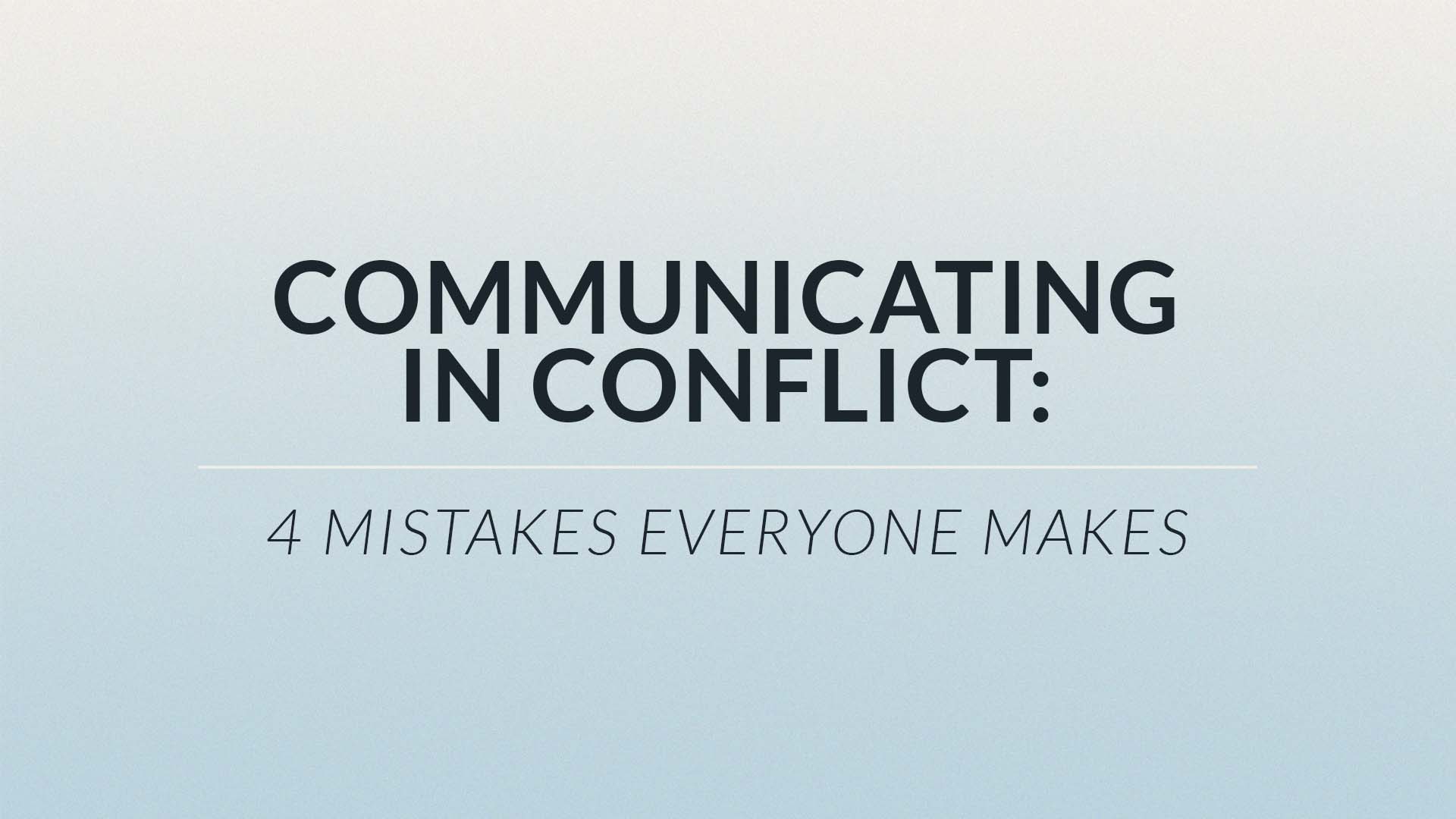Knowing how to communicate and resolve conflicts in relationships is a really big deal. For example, researchers can predict, with 90 percent accuracy, whether a married couple will eventually divorce just by spending a few minutes observing how the spouses resolve a disagreement. It’s that important.
Yet none of us are perfect in how we communicate in conflict. We all have weak spots. Those weaknesses can be divided into four categories, or four negative communication patterns. (The four negative communication patterns are adapted from the book A Lasting Promise by Scott Stanley, Daniel Trathen, Savanna McCain, and Milt Bryan.)
Everyone has a tendency to fall into at least one of these negative patterns, and most of us experience different ones at different times. The good news is that once you know what the negative patterns are, you can identify when you are making those mistakes and take steps to overcome them.
Below are descriptions of the four negative communication patterns. As you read through these, focus first and foremost on yourself. Don’t think of this as a way to diagnose and fix what is wrong with your spouse, roommate, family member, friend, or whoever else you might have a conflict with. It’s true that they, like everyone, will make some of these mistakes at times. But you can only change your own actions; you can’t control how the other person reacts. Draw a circle around yourself and fix everything within that circle. Then you can consider sharing this article with others so that they can learn to overcome their own mistakes.
The four negative communication patterns are:
Withdrawal (or Avoidance)
- What it is: The unwillingness to start or stay in important discussions. Withdrawal is when the other person brings up an issue and you retreat so you don’t have to discuss it. Avoidance is when you know of something that you should discuss, but you avoid bringing it up.
- What it looks like: If you walk away or leave the room in order to end an argument, that is withdrawal. It could also look like shutting down in the middle of a conversation or changing the subject so that you are no longer talking about the thing you want to avoid. It could even be you lying and saying that you agree with the other person (when you really don’t) just so that the argument will be over. Anything you might do in order to avoid having a conversation fits in this category.
- How to overcome it: Stay in the ring. If you’re a withdrawer and avoider, the solution is to simply stay in the conversation and address the issues that you’ve been avoiding. It can be hard, because it goes against your natural tendencies, but push through it. Recognize that the health of the relationship is worth the discomfort of working through your issues together. Make sure that you are having the conversations you need to have.
- Phrases to use: If you tend to withdraw or avoid, consider saying (perhaps to yourself): “OK, let’s talk about it. We can work it out. Our relationship is worth it.” If you find that someone else tends to withdraw or avoid having the conversation with you, ask them, “Is there anything about me and how I respond that makes it hard to talk about this?”
Ephesians 4:15 instructs us to speak the truth in love, and 1 Corinthians 13:6 says that love rejoices in the truth. It is loving to speak the truth (when spoken in a loving way, with the right motives). It might feel unloving to have hard conversations, but it is one of the best things you can do for the health of your relationship.
Escalation
- What it is: Responding to conflict by arguing and upping the ante, so that the conversation gets more heated and more hostile.
- What it looks like: People who escalate get angrier as the discussion goes on, sometimes to the point of yelling or becoming violent. Escalators have to get in the last word. You might try to make yourself feel better by making the other person feel worse, such as by bringing up other complaints. If you end up thinking, “How did we get here? What are we even fighting about?” then you have likely both been escalating. Escalation is like taking steps up a ladder. If both people escalate, then you quickly get to the top of the ladder, which is a very precarious place to be.
- How to overcome it: Don’t get on the ladder. Just don’t start up that path. If you find yourself escalating, call a timeout—literally. Say, “Let’s take a timeout. Let’s hit pause on this and come back to it later.” What keeps that from being avoidance is that you do come back to it; you set a time when you can discuss it in a calmer frame of mind.
- Phrases to use: “This conversation is really important to me. Can I take some time to think and pray about it, and we’ll get back together to discuss it more this evening?”
Proverbs 29:11 says that a fool gives full vent to his anger, and Proverbs 18:6 says that a fool’s lips walk into a fight. Don’t be a fool.
Negative Interpretation
- What it is: When someone automatically believes that the motives of the other person are more negative than is really the case.
- What it looks like: When someone makes a comment or does something that could be interpreted as either positive or negative, a negative interpreter chooses the negative. For example, you might get defensive at seemingly innocent questions, like “What did you do today?” Or, you might even take a positive comment, like “You look nice tonight,” and negatively interpret that to mean the person thinks you normally look terrible. If you are always wondering whether there is a hidden (negative) message behind the things other people say or do, you are a negative interpreter.
- How to overcome it: Believe the best. Whenever someone says something could be taken either way, positive or negative, assume the positive. If you are not sure of their intentions or you can’t help but think that they really were being negative, ask for clarification.
- Phrases to use: “When you say/do (thing that could be negatively interpreted), what do you mean by that?” “Help me understand what you mean.”
1 Corinthians 13:7 says that love “believes all things” and “hopes all things.” So, in our relationships with people we love, we want to believe the best about them and hope that they are truly on our side.
Invalidation
- What it is: A subtle or direct putdown of the thoughts, feelings, or character of the other person.
- What it looks like: This is when someone tells you what they think or how they feel, and instead of engaging or empathizing with them, you tell them that they shouldn’t think or feel that way. Instead of addressing their concerns, you declare that their concerns are not valid and therefore don’t have to be dealt with. Your first response is to try to “win” the argument at all costs. You might change the meaning of what they said in an attempt to manipulate them. Invalidation often happens because you assume that there’s no way you could be wrong; therefore, when someone else disagrees with you, they must be wrong. If someone comes to you with a concern, and then ends up apologizing for bringing it up, you know that you’re an invalidator.
- How to overcome it: Seek to understand. Instead of trying to win the argument, try to understand their point of view. Consider things from their perspective and try to feel what they are feeling. Be humble enough to realize that they might be right, you might be wrong, and God might be using His gift of community to help you see things from a different perspective.
- Phrases to use: “Help me understand why you feel that way.” “What I hear you saying, is…” (a.k.a. the speaker-listener technique).
James 4:6 and 1 Peter 5:5 both say that “God opposes the proud but gives grace to the humble.” The same is true of people: they will oppose you when you’re too proud to consider their side, but they will give grace when you are humble enough to listen, understand, and admit when you might be wrong.
Don’t Be a WENI
If you take those four negative communication patterns—withdrawal, escalation, negative interpretation, and invalidation—and turn them into an acronym, it spells WENI. It’s not the greatest acronym, but it does make it easier to remember: don’t be a WENI. Be aware of what your tendencies are, recognize when you are falling into those traps, and take steps to overcome them.
In every situation, and no matter what your negative communication tendencies might be, remember that the goal of communication is mutual understanding. You want to understand and be understood. The goal is not to “win” an argument and defeat your opponent. The real “win” is when you both understand each other, so that you can agree on a way to move forward together.


